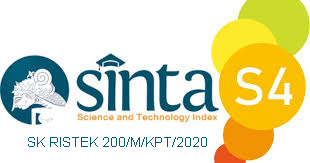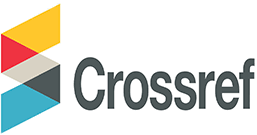COMPATIBILITY OF SELECTION OF STUDENT DEPARTMENTS USING k-NEAREST NEIGHBOR AND NAÏVE BAYES CLASSIFIER IN INFORMATICS PRIVATE VOCATIONAL SCHOOL, SERANG CITY
Abstract
Selection of majors by prospective students when registering at a school, especially a Vocational High School, is very vulnerable because prospective students usually choose a major not because of their individual wishes. And because of the increasing emergence of new schools in cities and districts in each province in Indonesia, especially in the province of Banten. Problems experienced by prospective students when choosing the wrong department or not because of their desire, so that it has an unsatisfactory value or value in each semester fluctuates, especially in their Productive Lessons or Competencies. To provide a solution, a departmental suitability system is needed that can provide recommendations for specialization or major suitability based on students' abilities through attributes that can later assist students in the suitability of majors. The process of classifying the suitability of majors in data mining uses the k-Nearest Neighbor and Naive Bayes Classifier methods by entering 16 (sixteen) criteria or attributes which can later provide an assessment of students through this test when determining the majors for themselves, and there is no interference from people. another when choosing a major later. Research that has been carried out successfully using the k-Nearest Neighbors method has a higher recall of 99%, 81% accuracy and 82% precision compared to the Naïve Bayes Classifier whose recall only yields 98% while the accuracy and precision is the same as the k- Nearest Neighbors.
Keywords
Full Text:
PDFReferences
Billyan, B. F., Bhawiyuga, A., & Primananda, R. (2017). Implementasi Metode Klasifikasi Fuzzy K-Nearest Neighbor ( FK-NN ) Untuk Fingerprint Access Point Pada Indoor Positioning. Jurnal Pengembangan Teknologi Informasi Dan Ilmu Komputer (JPTIK), 1(11).
Devita, R. N., Herwanto, H. W., & Wibawa, A. P. (2018). Perbandingan Kinerja Metode Naive Bayes dan K-Nearest Neighbor untuk Klasifikasi Artikel Berbahasa indonesia. Jurnal Teknologi Informasi Dan Ilmu Komputer, 5(4), 427. https://doi.org/10.25126/jtiik.201854773
Ariani, F., & Endra, R. Y. (2013). Implementation of Fuzzy Inference System with Tsukamoto Method for Study Progamme Selection. 2nd International Conference on Engineering and Technology Development (ICETD), Icetd, 189–200.
Ghaniy, R., & Sihotang, K. (2019). Penerapan Metode Naïve Bayes Classifier Untuk Penentuan Topik Tugas Akhir. Teknois : Jurnal Ilmiah Teknologi Informasi Dan Sains, 9(1), 63–72. https://doi.org/10.36350/jbs.v9i1.7
. Mafakhir, A. Z., & Solichin, A. (2020). Penerapan Metode Naïve Bayes Classifier Untuk Penjurusan Siswa Pada Madrasah Aliyah Al-Falah Jakarta. Fountain of Informatics Journal, 5(1), 21. https://doi.org/10.21111/fij.v5i1.4007
. Handayani, I., & Ikrimach, I. (2020). Accuracy Analysis of K-Nearest Neighbor and Naïve Bayes Algorithm in the Diagnosis of Breast Cancer. Jurnal Infotel, 12(4), 151–159. https://doi.org/10.20895/infotel.v12i4.547
. Antaristi, M., & Kurniawan, Y. I. (2017). Aplikasi Klasifikasi Penentuan Pengajuan Kartu Kredit Menggunakan Metode Naive Bayes di Bank BNI Syariah Surabaya. Jurnal Teknik Elektro, 9(2). https://doi.org/10.15294/jte.v9i2.12496
. Indrayuni, E. (2017). Text Mining dalam Analisis Sentimen Review Restoran Menggunakan Algoritma K-Nearest-Neighbor (KNN). JURNAL TEKNIK INFORMATIKA STMIK ANTAR BANGSA, 3(2).
Sipayung, E. M., Maharani, H., & Zefanya, I. (2016). Perancangan Sistem Analisis Sentimen Komentar Pelanggan Menggunakan Metode Naive Bayes Classifier. Jurnal Sistem Informasi.
Zuhri, F. N., & Alamsyah, A. (2017). Analisis sentimen masyarakat terhadap brand smartfren menggunakan naive bayes classifier di forum kaskus. E-Proceeding of Management.
Indriani, A. (2014). Klasifikasi Data Forum dengan menggunakan Metode Naïve Bayes Classifier. Seminar Nasional Aplikasi Teknologi Informasi (SNATI) Yogyakarta.
Oktasari, L., Chrisnanto, Y. H., & Yuniarti, R. (2016). Text Mining Dalam Analisis Sentimen Asuransi Menggunakan Metode Niave Bayes Classifier. Prosiding SNST.
Rivki, M., & Bachtiar, A. M. (2017). IMPLEMENTASI ALGORITMA K-NEAREST NEIGHBOR DALAM PENGKLASIFIKASIAN FOLLOWER TWITTER YANG MENGGUNAKAN BAHASA INDONESIA. Jurnal Sistem Informasi. https://doi.org/10.21609/jsi.v13i1.500
Rinawati, R. (2017). Penentuan Penilaian Kredit Menggunakan Metode Naive Bayes Berbasis Particle Swarm Optimization. J-SAKTI (Jurnal Sains Komputer Dan Informatika). https://doi.org/10.30645/j-sakti.v1i1.28
Saleh, A. (2015). Implementasi Metode Klasifikasi Naïve Bayes Dalam Memprediksi Besarnya Penggunaan Listrik Rumah Tangga. Creative Information Technology Journal.
DOI: https://doi.org/10.31326/jisa.v4i1.893
Refbacks
- There are currently no refbacks.
Copyright (c) 2021 Budi Pangestu

This work is licensed under a Creative Commons Attribution-ShareAlike 4.0 International License.
JOURNAL IDENTITY
Journal Name: JISA (Jurnal Informatika dan Sains)
e-ISSN: 2614-8404, p-ISSN: 2776-3234
Publisher: Program Studi Teknik Informatika Universitas Trilogi
Publication Schedule: June and December
Language: English
APC: The Journal Charges Fees for Publishing
Indexing: EBSCO , DOAJ, Google Scholar, Arsip Relawan Jurnal Indonesia, Directory of Research Journals Indexing, Index Copernicus International, PKP Index, Science and Technology Index (SINTA, S4) , Garuda Index
OAI address: http://trilogi.ac.id/journal/ks/index.php/JISA/oai
Contact: jisa@trilogi.ac.id
Sponsored by: DOI – Digital Object Identifier Crossref, Universitas Trilogi
In Collaboration With: Indonesian Artificial Intelligent Ecosystem(IAIE), Relawan Jurnal Indonesia, Jurnal Teknologi dan Sistem Komputer (JTSiskom)
JISA (Jurnal Informatika dan Sains) is Published by Program Studi Teknik Informatika, Universitas Trilogi under Creative Commons Attribution-ShareAlike 4.0 International License.


















